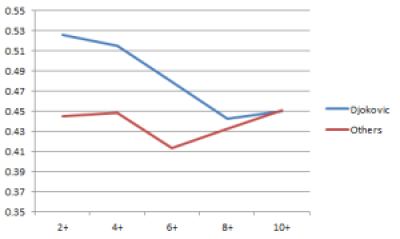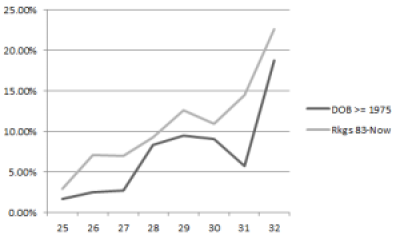Italian translation at settesei.it
Round robins–such as the formats used by the ATP and WTA Tour Finals–have a lot going for them. Fans are guaranteed at least three matches for every player, and competitors can recover from one (or even two) bad outings. Best of all, when compared to a knockout-style draw, it’s twice as much tennis.
On the other hand, round robins have one major drawback: They can result in meaningless matches. It’s fairly common that, after two matches, a player is guaranteed a spot in the semifinals (sometimes even a specific seed) or eliminated from contention altogether. At a high-profile event such as the Tour Finals, with sky-high ticket prices, do we really want to run the risk of dead rubbers?
I don’t claim to have the answer to that question. However, we can take a closer look at the round robin format to answer several relevant questions. What is the probability that the final day of a four-player group will include at least one dead rubber? What about the final match? And most importantly, before the event begins, can we set the schedule in such a way to minimize the likelihood of dead rubbers?
The range of possibilities
As a first step, let’s determine all of the possible outcomes of the first four matches in a four-player round robin group. For convenience, I’ll refer to the players as A, B, C, and D. The first day features two matches, A vs B and C vs D. The second day is A vs C and B vs D, leaving us with a final day of A vs D and B vs C.
Each match has four possible outcomes: the first player wins in two sets, the first player wins in three, the second wins in two, or the second wins in three. (Sets won are important because they are used as a tiebreaker when, for instance, three players win two matches apiece.) Thus, there are 4 x 4 x 4 x 4 = 256 possible arrangements of the group standings entering the final day of round robin play.
Of those 256 permutations, 32 of them (12.5%) include one dead rubber on the final day. In those cases, the other match is played only to decide semifinal seeding between the players who will advance. Another 32 of the 256 permutations involve one “almost-dead” match, between a player who has been eliminated and a player who is competing only to determine semifinal seeding.
In other words, one out of every four possible outcomes of the first two days results in a day three match that is either entirely or mostly meaningless. Later on, we’ll dig into the probability that these outcomes occur, which depends on the relative skill levels of the four players in the group.
Before we do that, let’s take a little detour to define our terms. Because of the importance of semifinal seeding, some dead rubbers are less dead than others. Further, it is frequently the case that one player in a match still has a shot at the semifinals and the other doesn’t. Altogether, from “live” to “dead,” there are six gradations:
- live/live — both players are competing to determine whether they survive
- live/seed — one player could advance or not; the other will advance, and is playing to try to earn the #1 group seed
- live/dead — one player is trying to survive; the other is eliminated
- seed/seed — both players will advance; the winner gets the #1 group seed
- seed/dead — one player is in the running for the #1 seed; the other is eliminated
- dead/dead — both players are eliminated
All else equal, the higher a match lies on that scale, the more engaging its implications for the tournament. For the remainder of this article, I’ll refer only to the “dead/dead” category as “dead rubbers,” though I will occasionally discuss the likelihood of “dead/seed” matches as well. I’ll assume that the #1 seed is always more desirable than #2 and ignore the fascinating but far-too-complex ramifications of situations in which a player might prefer the #2 spot.
The sixth match
As we’ve seen, there are many sequences of wins and losses that result in a dead rubber on day three. Once the fifth match is played, it is even more likely that the seedings have been determined, making the sixth match meaningless.
After five matches, there are 1,024 possible group standings. (256 permutations after the first four matches, multiplied by the four possible outcomes of the fifth match.) Of those, 145 (14.1%) result in a dead sixth rubber, and another 120 (11.7%) give us a “dead/seed” sixth match.
We haven’t yet determined how likely it is that we’ll arrive at the specific standings that result in dead sixth rubbers. So far, the important point is that dead rubbers on day three aren’t just flukes. In a four-player round robin, they are always a real possibility, and if there is way to minimize their likelihood, we should jump at the chance.
Real scenarios, really dead rubbers
To figure out the likelihood of dead rubbers in practical situations, like the ATP and WTA Tour Finals, I used a hypothetical group of four players with Elo ratings spread over a 200-point range.
Why 200? This year’s Singapore field was very tightly packed, within a little bit more than 100 points, implying that the best player, Angelique Kerber, had about a 65% chance of beating the weakest, Svetlana Kuznetsova. By contrast, the ATP finalists in London are likely to be spread out over a 400-point range, giving the strongest competitor, Novak Djokovic, at least a 90% edge over the weakest.
I’ve given our hypothetical best player a rating of 2200, followed by a field of one player at 2130, one at 2060, and one at 2000. Thus, our favorite has a 60% chance of beating the #2 seed, a 69% chance of defeating the #3 seed, and a 76% chance of besting the #4 seed.
For any random arrangement of the schedule, after the first two days of play, this group has a 17% chance of giving us a dead rubber on day three, plus a 23% chance of a “dead/seed” match on day three.
After the fifth match is contested, there is a 16% chance of that the sixth match is meaningless, with an additional 12% chance that the sixth match falls into the “dead/seed” category.
The wider the range of skill levels, the higher the probability of dead rubbers. This is intuitive: The bigger the range between the top and bottom, the more likely that the best player will win their first two matches–and the more likely they will be straight-setters. Similarly, the chances are higher that the weakest player will lose theirs. The higher the probability that players go into day three with 2-0 or 0-2 records, the less likely that day three matches have an impact on the outcome of the group.
How to schedule a round robin group
A 17% chance of a dead rubber on day three is rather sad. But there is a bright spot in my analysis: By rearranging the schedule, you can raise that probability as high as 24.7% … or drop it as low as 10.7%.
Remember that our schedule looks like this:
Day one: A vs B, C vs D
Day two: A vs C, B vs D
Day three: A vs D, B vs C
We get the lowest possible chance of a day three dead rubber if we put the players on the schedule in order from weakest to strongest: A is #4, B is #3, and so on:
Day one: #4 vs #3, #2 vs #1
Day two: #4 vs #2, #3 vs #1
Day three: #4 vs #1, #3 vs #2
There is a small drawback to our optimal arrangement: It increases the odds of a “dead/seed” match. It turns out that you can only optimize so much: No matter what the arrangement of the competitors, the probability of a “dead/dead” or “dead/seed” match on day three stays about the same, between 39.7% and 41.7%. While neither type of match is desirable, we’re stuck with a certain likelihood of one or the other, and it seems safe to assume that a “dead/seed” rubber is better than a totally meaningless one.
Given how much is at stake, I hope that tournament organizers heed this advice and schedule round robin groups in order to minimize the chances of dead rubbers. The math gets a bit hairy, but the conclusions are straightforward and dramatic enough to make it clear that scheduling can make a difference. Over the course of the season, almost every tennis match matters–it would be nice if every match at the Tour Finals did, too.
(I wrote more about this, which you can read here.)



